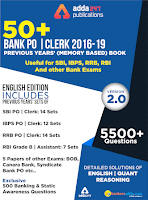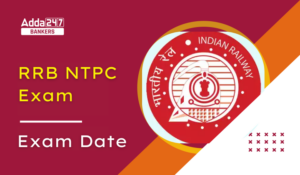Reasoning Questions for SBI CLERK Main 2019
Reasoning Ability is a crafty section.It eventually affects the number of question one can usually attempt. But this section is based on logic and rules can be aced if practised well enough. The only way to achieve this ambitious goal is by practising continuously with dedication. So to prepare you with best tools for the finals, here is today’s Reasoning Quiz based on the study plan and the exact same pattern of questions that are expected to be asked in SBI Clerk Main 2019.
Directions (1-5): Study the following information and answer the given questions:
Eight persons are sitting around a circular table in such a way some are facing inside while some are facing outside. All persons are different ages and likes different colours.
F sits third to the left of G who likes yellow colour. A is third oldest person and sits second to the right of the second oldest person who likes pink colour. The one who likes blue colour sits immediate right of the one who likes white colour. Two persons sit between B and E who is an immediate neighbour of G. F sits third to the right of A. D is older than only three persons. H sits second to the left of the one who likes olive colour. C is younger than F but older than D. Neither B nor E likes olive colour. Second youngest person likes green colour. The one who likes magenta colour sits immediate right of the oldest person. E is older than G but younger than H who faces inside. The one who likes purple sits third to the left of the one who likes white colour. B and A faces each other. D and E facing same direction but opposite to G. B is younger than H.
Q1. Who among the following person sits second to the left of third youngest person?
the one who likes white colour
the youngest person
the one who sits second to the right of A
G
None of these
Q2. Who among the following person likes Olive colour?
F
A
C
D
None of these
Q3. Which of the following statement is not true about D?
D likes purple colour
the one who likes Blue colour is younger than D
D is older than E
D sits second to the right of F
All are true
Q4. How many persons sits between H and G, when counted right of G?
One
Three
None
Two
More than four
Q5. Which of the following colour likes by third oldest person?
Blue
White
Magenta
Pink
None of these
Directions (6-10): Each of the questions below consists of a question and two statements numbered I and II given below it. You have to decide whether the data provided in the statement are sufficient to answer the question. Read both the statements and
Given answer:
Given answer:
Q6. Certain number of persons are sitting in a row facing north. Who among the following sits immediate right of C?
I. Only three persons sit between A and D who sits one of the
ends. B sits third to the right of C who is not an immediate neighbour of F.
I. Only three persons sit between A and D who sits one of the
ends. B sits third to the right of C who is not an immediate neighbour of F.
II. C sits fourth to the right of H. E sits second to the left
of B who sits one of the extreme ends. F neither immediate neighbour of H nor
E.
of B who sits one of the extreme ends. F neither immediate neighbour of H nor
E.
If the data in statement I alone are sufficient to answer the question, while the data in statement II alone are not sufficient to answer the question.
If the data in statement II alone are sufficient to answer the question, while the data in statement I alone are not sufficient to answer the question.
If the data either in statement I alone or in statement II alone are sufficient to answer the question.
If the data even in both statements I and II together are not sufficient to answer the question.
If the data in both statement I and II together are necessary to answer the question.
Solution:
By combining both the statement we can find E sits immediate right of C.
Q7. There are six persons- P, Q, R, S, T and U in a family. Who among the following is daughter of P?
I. S is father of T who is grandchild of R. P is
daughter-in-law of U.
daughter-in-law of U.
II. P is daughter-in-law of R who is father of S. U is
grandmother of Q.
grandmother of Q.
If the data in statement I alone are sufficient to answer the question, while the data in statement II alone are not sufficient to answer the question.
If the data in statement II alone are sufficient to answer the question, while the data in statement I alone are not sufficient to answer the question.
If the data either in statement I alone or in statement II alone are sufficient to answer the question.
If the data even in both statements I and II together are not sufficient to answer the question.
If the data in both statement I and II together are necessary to answer the question.
Q8. Six persons A, B, C, D, E and F of different heights . Which of the following is the tallest among all?
I. C is taller than E but shorter than F. B is taller than E
but shorter than C, which is shorter than A.
but shorter than C, which is shorter than A.
II. B is just taller than A, but shorter than D. F is taller
than C but shorter than A.
than C but shorter than A.
If the data in statement I alone are sufficient to answer the question, while the data in statement II alone are not sufficient to answer the question.
If the data in statement II alone are sufficient to answer the question, while the data in statement I alone are not sufficient to answer the question.
If the data either in statement I alone or in statement II alone are sufficient to answer the question.
If the data even in both statements I and II together are not sufficient to answer the question.
If the data in both statement I and II together are necessary to answer the question.
Solution:
Both statements are not sufficient to answer the question.
Q9. What is code for ‘Book’ ?
I. If the code for
“This book is interesting” is “ sx lx zt fx” and the code of “ Book good source
knowledge” is “ lv xs lx mn”.
“This book is interesting” is “ sx lx zt fx” and the code of “ Book good source
knowledge” is “ lv xs lx mn”.
II. The code for “Book notes good source” is “ lv tu lx mn”.
If the data in statement I alone are sufficient to answer the question, while the data in statement II alone are not sufficient to answer the question.
If the data in statement II alone are sufficient to answer the question, while the data in statement I alone are not sufficient to answer the question.
If the data either in statement I alone or in statement II alone are sufficient to answer the question.
If the data even in both statements I and II together are not sufficient to answer the question.
If the data in both statement I and II together are necessary to answer the question.
Solution:
By using Statement I, we can find code for ‘Book’ is ‘lx’.
Q10. Six persons A, B, C, D, E and F meeting on different days of week from Monday to Saturday. Who among the following going on Wednesday?
I. B goes on Thursday. Only one person goes between B and C. A
goes immediately before C. Only one person goes between D and A.
goes immediately before C. Only one person goes between D and A.
II. Only three persons go between A and C. No one goes between
D and B. A goes on one of the days before C. Only three persons go between B
and E.
D and B. A goes on one of the days before C. Only three persons go between B
and E.
If the data in statement I alone are sufficient to answer the question, while the data in statement II alone are not sufficient to answer the question.
If the data in statement II alone are sufficient to answer the question, while the data in statement I alone are not sufficient to answer the question.
If the data either in statement I alone or in statement II alone are sufficient to answer the question.
If the data even in both statements I and II together are not sufficient to answer the question.
If the data in both statement I and II together are necessary to answer the question.
Directions (11-13): In the following questions, the symbols #, &, @, * , $, % and © are used with the following meanings as illustrated below. Study the following information and answer the given questions:
P@Q- P is the child of Q
P©Q- P is the parent of Q
P%Q- P is father-in-law of Q
P&Q- P is brother-in-law of Q
P$Q- P is brother of Q
P*Q- P is wife of Q
Q11. If the expression ‘K$O*L%R*T’ is true, then how T is
related to K?
related to K?
Brother
Nephew
Grandson
Niece
None of these
Q12. If the expression ‘M&S*U©W$X’ is true, then Which of the following is definitely true?
X is son of M
U is sister of M
M is aunt of W
S is mother of W
None of these
Q13. If the expression ‘A©D@E$G*K’ is true, then which of the following is false?
A is sister-in-law of G
G is aunt of D
K is brother-in-law of E
A is father of D
None of these
Directions (14-15): Study the following information carefully and answer the given questions:
In coded
language
language
“Instant Meeting Question” is coded as – ‘Q# I# M$’
“Artificial Blogger Picture” is coded as – ‘’X# Y$ J$’
Q14. What is the code for ‘Workplace’?
Q14. What is the code for ‘Workplace’?
U$
C$
O#
P$
None of these
Q15. What is the code for ‘Farewell’?
T#
L$
D#
T$
None of these
You may also like to Read:
- Check the Study related Articles Here
- Study Notes for All Banking Exams 2018
- Bankers Adda Daily Questions for SBI PO, IBPS PO Clerk & Bank Exams











 GA Capsule for SBI Clerk Mains 2025, Dow...
GA Capsule for SBI Clerk Mains 2025, Dow...
 The Hindu Review October 2022: Download ...
The Hindu Review October 2022: Download ...
 RRB NTPC Exam Date 2025 Soon, Check Expe...
RRB NTPC Exam Date 2025 Soon, Check Expe...





